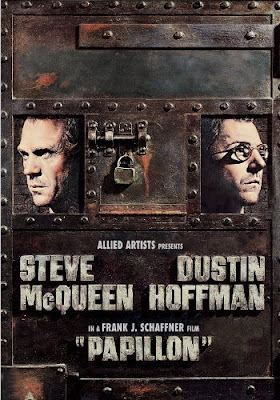The Perils of Papillon
I’ve always been curiousabout Papillon. This 1973 film, directed by Franklin J. Schaffner (Patton)derives from the purportedly true memoir of Henri Charrière, a low-levelcriminal who successfully escaped from the French penal colony of Devil’sIsland, off the northeastern coast of South America. Grim survival stories arenot especially favorites of mine, but circa 1985 I paid a visit to Guyane (akaFrench Guiana), where a family member was preparing for the launch of anAmerican satellite on a European rocket based at the local space center. Notfar from these high-tech surroundings was the Isle du Diable, and I was luckyto join a group of French journalists touring this infamous but now defunctsite, which was the center of the French penal system from 1852 to 1952.
I don’t remember much aboutthe prison environment, except that it was a hot and brutal place, full ofinsects and other daunting obstacles. Schaffner’s film makes full use of these obstacles,both the natural and the man-made, in telling the story of a bloke with abutterfly tattooed on his chest (hence the nickname Papillon) and anindomitable will to survive. His leading man is Steve McQueen, known throughouthis career as an escape artist par excellence. McQueen is anextraordinarily physical actor, blessed with a hard body and a stoic face thatseems to accept danger as man’s natural lot. His job in this film is to survive,even when locked in a steel cage and deprived of any source of light. Attimes we see his agonized efforts to hold onto his humanity, despite it all.Many feel this is McQueen’s very best work.
I began thinking about Papillonafter I was interviewed by Kelsy Norman, a Canadian film buff (and ultimateMcQueen fan) whose long-running podcast is called SPEEDING BULLITT: THELIFE AND FILMS OF STEVE MCQUEEN. I hardly claim to be a McQueen expert, butKelsy had read my Seduced by Mrs. Robinson: How The Graduate Becomesthe Touchstone of a Generation, and was intrigued by my report of whatMcQueen had told his then-wife, now Neille Adams Toffel, after watching DustinHoffman in 1967’s The Graduate. Said he, “God, baby, I can’t believethis guy’s going to be a movie star, can you? I mean, he is one ugly cat. Goodactor, yeah, but he sure is homely.” McQueen, always secretly insecure, brooded mightily about the possibility thathe and such classically handsome talents as Paul Newman might be shoved asideby the newcomer. Toffel writes in her memoir that “Steve would stare at hisimage in the mirror and say to me, ‘Look at that, baby, take a look at thatface and that body and tell me the truth. Who would you pick, him or me?’ Wewould both laugh, although I knew he was serious.”
As luck would have it, whenMcQueen began work on Papillon, he discovered he’d be playing againstthis very same Dustin Hoffman. Hoffman plays Louis Dega, a fellow prisonerwho’s the polar opposite of Papillon in many ways. Dega is whip-smart, but alsoextremely cautious: there’s nothing of the escape artist about him. In time,against all odds, the two become friends. At perhaps Papillon’s lowest point,when he’s been thrown into solitary with his already bug-infested rationshalved, Dega secretly comes to his aid. But the friendship between the twoprisoners hardly extended to the two actors. McQueen, recognizing Hoffman’stalent, decided he needed to up his game on-screen. But a real-life friendshipbetween the two was not in the cards.
Here's my interview with Kelsy Norman on his Speeding Bullitt podcast, which covers all things Steve McQueen.
Beverly in Movieland
- Beverly Gray's profile
- 10 followers




